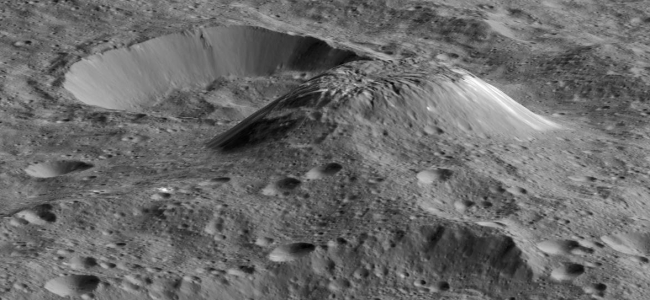Ceres’s big mountain

The Dawn science team has released an oblique angle image of Ceres’s big mountain, Ahuna Mons. I have cropped and reduced it above to show it here.
Despite looking almost toylike in this image, the mountain is quite monstrous, especially considering Ceres’s relatively small size.
This mountain is about 3 miles (5 kilometers) high on its steepest side. Its average overall height is 2.5 miles (4 kilometers). These figures are slightly lower than what scientists estimated from Dawn’s higher orbits because researchers now have a better sense of Ceres’ topography.
Consider: Mount Everest is not quite six miles high, on a planet with a diameter about 7926 miles across. Ceres however is only about 600 miles across at its widest, which means a 3 mile high mountain is 0.5% of Ceres’s entire width! Such a thing could only occur on such a small body, whose gravity is not quite great enough to force things into a completely spherical shape. It is for this reason it could be argued that Ceres doesn’t qualify as a dwarf planet, but would be better labeled a giant asteroid.
On Christmas Eve 1968 three Americans became the first humans to visit another world. What they did to celebrate was unexpected and profound, and will be remembered throughout all human history. Genesis: the Story of Apollo 8, Robert Zimmerman's classic history of humanity's first journey to another world, tells that story, and it is now available as both an ebook and an audiobook, both with a foreword by Valerie Anders and a new introduction by Robert Zimmerman.
The print edition can be purchased at Amazon or from any other book seller. If you want an autographed copy the price is $60 for the hardback and $45 for the paperback, plus $8 shipping for each. Go here for purchasing details. The ebook is available everywhere for $5.99 (before discount) at amazon, or direct from my ebook publisher, ebookit. If you buy it from ebookit you don't support the big tech companies and the author gets a bigger cut much sooner.
The audiobook is also available at all these vendors, and is also free with a 30-day trial membership to Audible.
"Not simply about one mission, [Genesis] is also the history of America's quest for the moon... Zimmerman has done a masterful job of tying disparate events together into a solid account of one of America's greatest human triumphs."--San Antonio Express-News

The Dawn science team has released an oblique angle image of Ceres’s big mountain, Ahuna Mons. I have cropped and reduced it above to show it here.
Despite looking almost toylike in this image, the mountain is quite monstrous, especially considering Ceres’s relatively small size.
This mountain is about 3 miles (5 kilometers) high on its steepest side. Its average overall height is 2.5 miles (4 kilometers). These figures are slightly lower than what scientists estimated from Dawn’s higher orbits because researchers now have a better sense of Ceres’ topography.
Consider: Mount Everest is not quite six miles high, on a planet with a diameter about 7926 miles across. Ceres however is only about 600 miles across at its widest, which means a 3 mile high mountain is 0.5% of Ceres’s entire width! Such a thing could only occur on such a small body, whose gravity is not quite great enough to force things into a completely spherical shape. It is for this reason it could be argued that Ceres doesn’t qualify as a dwarf planet, but would be better labeled a giant asteroid.
On Christmas Eve 1968 three Americans became the first humans to visit another world. What they did to celebrate was unexpected and profound, and will be remembered throughout all human history. Genesis: the Story of Apollo 8, Robert Zimmerman's classic history of humanity's first journey to another world, tells that story, and it is now available as both an ebook and an audiobook, both with a foreword by Valerie Anders and a new introduction by Robert Zimmerman.
The print edition can be purchased at Amazon or from any other book seller. If you want an autographed copy the price is $60 for the hardback and $45 for the paperback, plus $8 shipping for each. Go here for purchasing details. The ebook is available everywhere for $5.99 (before discount) at amazon, or direct from my ebook publisher, ebookit. If you buy it from ebookit you don't support the big tech companies and the author gets a bigger cut much sooner.
The audiobook is also available at all these vendors, and is also free with a 30-day trial membership to Audible.
"Not simply about one mission, [Genesis] is also the history of America's quest for the moon... Zimmerman has done a masterful job of tying disparate events together into a solid account of one of America's greatest human triumphs."--San Antonio Express-News


Ceres, is not an asteroid??? When did that happen. When I was a kid all the astronomy books said Vesta and Ceres were the two largest asteroids. Were they lying? Next thing you’ll be telling me that Pluto isn’t a planet…
Strange how this new naming system doesn’t clarify anything which leads me to suspect is was done more to gratify big egos who just wanted to shake things up because they could.
It happened when Pluto was demoted. According to Wikipedia (that bastion of reliability), its categorization has quite a history:
https://en.wikipedia.org/wiki/Ceres_(dwarf_planet)#Classification
It all seems very confusing. Perhaps the IAU has not done us (m)any favors, so far this millennium.
Edward!
HAR! You make me smile & that’s not always easy for me– enjoy your brand of humor!!